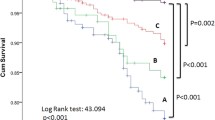Abstract
A low body mass index (BMI) and serum albumin are associated with increased risk of mortality in patients with chronic kidney disease (CKD). The purpose of this study was to evaluate BMI and serum albumin as predictors of all-cause and cardiovascular (CV) mortality in hemodialysed (HD) patients. We describe the results of a five-year retrospective observational study with 187 HD patients (54.9 ± 15.6 years old, 54% men, and 46% suffering from diabetes) from RenalCor Clinic in Rio de Janeiro, Brazil. The influence of serum albumin levels and BMI (determined every three months) over all-cause mortality was examined using a Cox model, while the influence of the same factors over CV mortality among all-cause mortality was modeled through a logistic regression. During the five years, 26.7% of the patients died, 62% of which due to CV disease (CVD). Analysis by the Cox model showed that low serum albumin and low BMI were significant predictors of mortality. Patients with higher BMI had a lower hazard of death for all-cause mortality (hazard ratio [HR] = 0.92; P = 0.035) and a 1 g/l increase in serum albumin was associated with significantly lower hazard of death (hazard ratio = 0.9679; P < 0.001). The highest BMI value (>30 kg/m2) was significantly associated with an increase of odds of CV mortality (odds ratio = 1.22, P = 0.03). We confirm here in a Brazilian cohort of hemodialysis patients that both low BMI (<19 kg/m2) and hypoalbuminemia are strong predictors of death.


Similar content being viewed by others
References
Stenvinkel P (2005) Inflammation in end-stage renal disease: a fire that burns within. Contrib Nephrol 149:185–199
Kalantar-Zadeh K, Kilpatrick RD, Kuwae N et al (2005) Revisiting mortality predictability of serum albumin in the dialysis population: time dependency, longitudinal changes and population-attributable fraction. Nephrol Dial Transplant 20(9):1880–1888
Kaizu Y, Tsunega Y, Yoneyama T et al (1998) Overweight as another nutritional risk factor for the long-term survival of non-diabetic hemodialysis patients. Clin Nephrol 50(1):44–50
Nurmohamed SA, Nube MJ (2005) Reverse epidemiology. Paradoxical observations in haemodialysis patients. Neth J Med 63(10):376–381
World Health Organization (1995) Physical status: the use and interpretation of anthropometry. Report of a WHO expert committee (WHO technical report series, no. 854), Geneva, 1995
World Health Organization (1997) International obesity task force. Managing the global epidemic of obesity. Report of the WHO Consultation on obesity, Geneva
Sarnak MJ, Levey AS (2000) Cardiovascular disease and chronic renal disease. A new paradigm. Am J Kidney Dis 35:S117–S131
Leavey SF, Strawderman RL, Camille AJ et al (1998) Simple nutritional indicators as independent predictors of mortality in hemodialysis patients. Am J Kidney Dis 31:997–1006
Fleischmann E, Teal N, Dudley J et al (1999) Influence of excess weight on mortality and hospital stay in 1346 hemodialysis patients. Kidney Int 55:1560–1567
Marcen R, Teruel J, de la Cal M et al (1997) The Spanish cooperative study of nutrition in hemodialysis. The impact of malnutrition in morbidity and mortality in stable hemodialysis patients. Nephrol Dial Transplant 12:2324–2334
Monteiro CA, Conde WL, Popkin BM (2004) The burden of disease from undernutrition and overnutrition in countries undergoing rapid nutrition transition: a view from Brazil. Am J Public Health 94(3):433–434
Leal VO, Aguiar LSM, Granto R, Mafra D (2006) Metabolic acidosis in non dialysed chronic kidney disease patients. Bio Farma-Rev Tec Cient Farm Bioquim Anal Clin Toxicol 1(1):22–28
Salahudeen AK (2003) Obesity and survival on dialysis. Am J Kidney Dis 41:925–932
Leavey SF, McCullough K, Hecking E et al (2001) Body mass index and mortality in “healthier” as compared with “sicker” haemodialysis patients: results from the Dialysis Outcomes and Practice Patterns Study (DOPPS). Nephrol Dial Transplant 16:2386–2394
Kopple JD, Zhu X, Lew NL et al (1999) Body weight-for-height relationships predict mortality in maintenance hemodialysis patients. Kidney Int 56:1136–1148
Port FK, Ashby VB, Dhingra RK et al (2002) Dialysis dose and body mass index are strongly associated with survival in hemodialysis patients. J Am Soc Nephrol 13:1061–1066
Aoyagi T, Naka H, Miyaji K et al (2001) Body mass index for chronic hemodialysis patients: stable hemodialysis and mortality. Int J Urol 8:S71–S75
Kutner NG, Zhang R (2001) Body mass index as a predictor of continued survival in older chronic dialysis patients. Int Urol Nephrol 32:441–448
Johnson DW, Herzig KA, Purdie DM et al (2000) Is obesity a favorable prognostic factor in peritoneal dialysis patients? Perit Dial Int 20:715–721
Hakim RM, Lowrie E (1999) Obesity and mortality in ESRD: is it good be fat? Kidney Int 55(4):1580–1581
Johansen KL, Kutner NG, Young B et al (2006) Association of body size with health status in patients beginning dialysis. Am J Clin Nutr 83(3):543–549
Beddhu S, Pappas LM, Ramkumar N et al (2003) Effects of body size and body composition on survival in hemodialysis patients. J Am Soc Nephrol 14(9):2366–2372
Kalantar-Zadeh K, Kuwae N, Wu DY et al (2006) Associations of body fat and its changes over time with quality of life and prospective mortality in hemodialysis patients. Am J Clin Nutr 83(2):202–210
Friedman AN (2006) Adiposity in dialysis: good or bad? Semin Dial 19(2):136–140
Kalantar-Zadeh K, Kopple JD, Kilpatrick RD et al (2005) Association of morbid obesity and weight change over time with cardiovascular survival in hemodialysis population. Am J Kidney Dis 46(3):489–450
Combe C, Chaveau P, Laville M et al (2001) Influence of nutritional factors and hemodialysis adequacy on the survival of 1,610 French patients. Am J Kidney Dis 37:S81–S88
Acknowledgments
We would like to thank Álvaro A.F. Pereira for his help in editing the manuscript.
Author information
Authors and Affiliations
Corresponding author
Rights and permissions
About this article
Cite this article
Mafra, D., Farage, N.E., Azevedo, D.L. et al. Impact of serum albumin and body-mass index on survival in hemodialysis patients. Int Urol Nephrol 39, 619–624 (2007). https://doi.org/10.1007/s11255-007-9201-2
Received:
Accepted:
Published:
Issue Date:
DOI: https://doi.org/10.1007/s11255-007-9201-2




